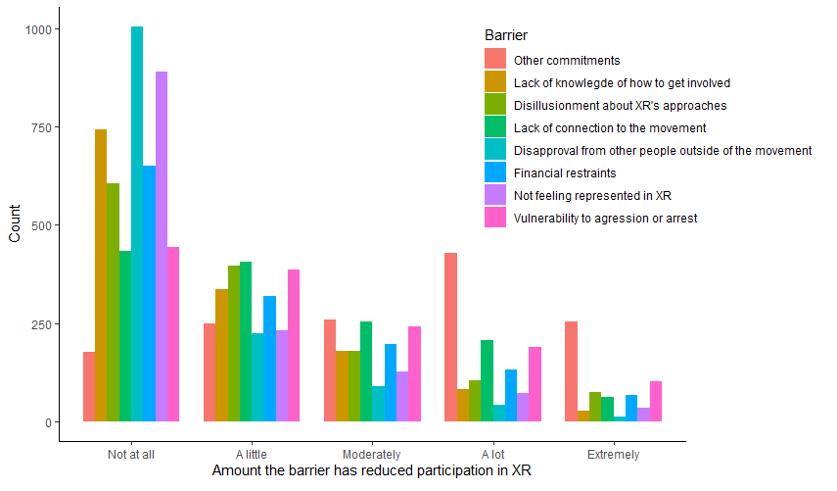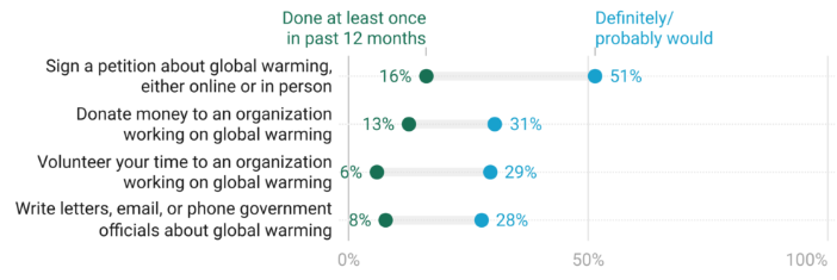Barriers to Climate Activism
Summary
Encouraging involvement
Recommendations from a 2024 study to bring people in to a climate movement were:
- ask people directly to get involved
- make it easy and show people how to do it
- provide options and describe their benefits
- strengthen perceptions of collective efficacy
- encourage talking about climate change and provide guidance
- amplify pro-climate social norms and diverse public voices
Barriers to involvement
Barriers are individual, social, or organisational mechanisms that prevent engagement, make it more difficult, or leaving more likely.
Overall, the main barriers to engagement in climate activism appear to be:
- not having been asked to get involved
- not knowing how to get involved
- other people being better at it
- lack of training/knowledge
- not having enough time
In addition, and specifically to XR, a 2021 study found that Black, Asian and Minority Ethnic (BAME) and working-class communities were put off by:
- the demographics of XR
- personal capacity issues and lack of understanding of these by XR
- failure to address the root cause of climate change—the economic system
In XRUK email list subscribers who completed the last Movement Survey, the barrier that by far most reduces their participation was other commitments. Vulnerability to aggression or arrest was also seen as a barrier.
XR email list subscribers
In the December 2024 Movement Survey, we asked respondents specifically about the extent to which a series of barriers have reduced their participation in XR.

Barriers
The barrier that the most respondents cited as reducing their involvement in the movement was other commitments. Only 13% of respondents said that this did not reduce their involvement at all. Vulnerability to aggression or arrest was seen as reducing participation by a lot and extremely by 14% and 7% of respondents respectively.
Not barriers
Lack of knowledge about the movement, disapproval from other people outside the movement and not feeling represented in XR were not seen by most (over 50%) as barriers to participation.
More in-depth research from this survey is being prepared (ready to share around the end of August).
BAME / Working Class
In 2021 there was a specific study [1] looking at “the extent to which Extinction Rebellion speaks to, and for, Black, Asian and Minority Ethnic (BAME) and working-class communities”.
Although a lot has changed in the past four years, it’s still very relevant research. Some of the main barriers to involvement in XR were:
- lack of information about how to get involved
- the perceived demographic make-up of XR
- problems with the group’s culture
- XR’s tactics (it’s important to note that this study was in 2021 and may have been addressed by the shift away from NVDA in 2023, but it’s also possible that XR is still associated with this type of action)
A further barrier to involvement were the limitations of the participants’ own lives which undermined their time, finances, energy and emotional capacity for campaigning and protesting, and the fact that some of the XR representatives and activists did not seem to recognise these constraints. In addition, some research participants considered XR to be ineffective because it fails to address the root cause of climate change—the economic system.
In the United Kingdom, activists of color reported that it was harder for them to enter and belong to the existing climate movements [2]. Additionally, they were more concerned about being targeted by police or racist attacks, which hindered them from joining actions. Thus, inequalities affect who joins climate activism and how they experience it.
'Concerned' public
Although not specific to XR, academic research has been done to look at barriers to involvement in climate change activism in general.
The main three types of personal barriers described in the literature are:
- Psychological barriers include low efficacy beliefs (i.e. not believing that you can make a change) and feeling distant to climate change or climate activism [3] [4]
- Lack of knowledge
- Not having enough time and energy [3] [5]
- Not knowing any activists
- Concerns about outside rejection
- Difficulties orienting in a new social environment
A study in 2022 showed that for people who are highly concerned about climate change, the most frequent reasons for lack of involvement in activism were:
- other people are better at it (57%)
- hadn’t been trained (57%)
- hadn’t been asked (51%)
- not knowing how to get involved (50%)
- activities like letter writing not appealing (50%)
- organizations would ask them for money (40%)
- too busy (39%)
- not encouraged to become involved (38%)
In Australians alarmed by the climate crisis, ‘no experience’ and ‘time poor’ were cited as barriers to engagement with climate-focused activism.[6]
A study in 2024 [7] in the US found that the majority of people who said they would definitely/probably undertake climate activism haven’t done so in the last 12 months. This was also reflected in the XR Membership Survey.

The main barrier to activism found in this study was that no one has ever asked them to do it. In addition, many say that it wouldn’t make any difference, they are not activists, they don’t know who to contact, or they wouldn’t know what to say.
The article provides the advice listed in the summary at the top of this page.
References
[1] Bell and Bevan, ‘Beyond Inclusion?’
[2] Wong et al., 2024
[3] Castiglione et al., 2022
[4] Fine, 2024
[5] Latkin et al., ‘Perceived Barriers to Climate Change Activism Behaviors in the United States Among Individuals Highly Concerned about Climate Change’.
[6] Whitson et al., ‘Three Profiles of Australian Climate Change Activism Have Both Unique and Overlapping Motivators and Barriers’.
[7] Ballew et al., ‘The Attitude-Behavior Gap on Climate Action’.
